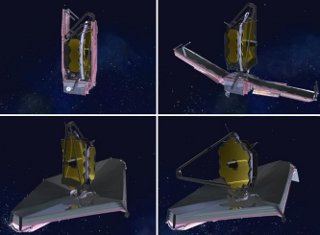James Webb Space Telescope Unfolding: The JWST will be the successor to the Hubble Space Telescope. It's 6.5-meter mirror is too large to fit into any space transportation vehicle for launch, so the design requires several smaller mirrors that will align after launch to create a large primary mirror.
Credit: NASA
After the COBE project was finished, I started thinking about new designs for cooled telescopes in space that could be more powerful than the old ones. I knew NASA was planning to build a cold infrared telescope. This telescope came to be known as the Spitzer Space Telescope, the last of the Great Observatories. Spitzer is a fantastic telescope but it is not large enough to answer certain kinds of questions that require looking back to the early Universe.
That started me thinking, can we build a bigger, cold infrared telescope? And how would we fit this giant, cold telescope on a rocket to get into space? If we don’t have a big enough rocket, how about building a telescope that could fold up into a smaller one for launch and then be unfolded once it is in space? I started sort of sketching out all these ideas. Some my friends even teased me that it was too complicated to succeed.
Around the same time, a committed group of scientists from various institutions was formed to discuss what NASA should do after the Hubble Space Telescope mission ended. Hubble was launched in 1990 to do work mostly in visible and ultraviolet wavelengths of light. Pretty soon we found out it was not focused properly, but a few years after it was fixed we started getting amazing, surprising information. By 1995 NASA wondered, “We have this amazing success. What are we going to do next?”
Then one day I received a phone call asking me to be the chief scientist at Goddard Space Flight Center to work on this new infrared mission. Of course, I said yes! And now I monitor the design and construction of the James Webb Space Telescope (JWST) to assure that the prime science goals are achievable.


